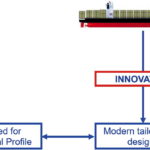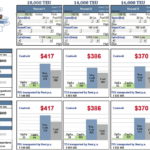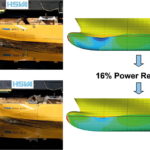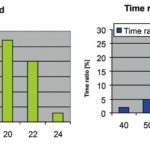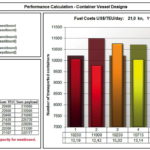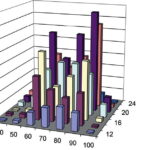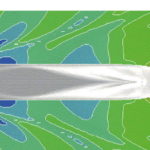A revolution of global transportation – and a look into the future. Part two: new reality in container shipping and new design requirements.
Changes in the global economy have resulted in a special focus on cost efficiency in the shipping industry in general[ds_preview] and in container shipping in particular. As fuel costs rise exorbitantly, liner operators are opting for vessels with lower fuel consumption. Apart from the cost factor, environmental aspects must increasingly be taken into account. Public awareness has also made ship operators reflect their customers’ desires in this respect. New rules and legislation introduced by IMO, ports and governments have either already been implemented or will come into force soon.
All these measures aim to purposely help to reduce global air emissions and water pollution. MARPOL Annex VI Tier II & III, extended ECAs and indices such as the EEDI, EEOI and ESI target the reduction of pollution as well as improved energy efficiency and can be used as benchmarks for the design of new vessels.
In addition, the change in the infrastructure in some areas has redrafted limitations in past designs. When thinking about new designs of mega-sized vessels, for instance, the extension of the Panama Canal plays a significant role. In the wake of seaports being constantly developed to include new technologies like gantries or IT logistics systems, other factors must also be considered. Of course, this has an impact on the requirements for seagoing vessels too.
As a matter of fact, container vessels are usually designed to have a lifecycle of about 25 years. Consequently, most of the existing fleet has been designed to meet earlier standards and is not in accordance with either current or future requirements. In spite of the present difficulties in financing ships, a certain number of newbuildings will be built. Their designs will focus on cost control and environmental aspects and will thus be more competitive than older designs.
Changed design requirements
The concept for the about 4,900 ships (according to Alphaliner) of the existing cellular fleet of conventionally designed ships was:
• A design according to one theoretical point, the so-called design point. The sea trial and evaluation of ship performance only confirm this point by a correction factor. However, the ship nearly always sails in so-called »off design« conditions.
• High velocity
• Standard shipyard designs, particularly for owners of chartered vessels
• Full order books made shipyards reluctant to change their proven uniform designs.
• Financing was basically a standard procedure using the German KG model.
New reality
Trends for new container vessels:
• Flexible speed and slow steaming with the ability to reach a high maximum speed (somewhat lower than the maximum speed of the older designs)
• Different main dimensions of length and width as well as block coefficients
• Larger designs to achieve economy of scale
• Important elements in the competition for charter parties are the vessel’s fuel efficiency and cost structure.
• Apart from the test and / or design conditions, the vessel’s real performance when in operation is important and brought more and more into focus. The basis for this is the so-called »operational profile«.
• New environmental rules and regulations have entered into force or will do so in the near future.
• The Energy Efficiency Design Index (EEDI) will be an important benchmark, particularly for newbuildings, in order to compare the quality of vessels.
• To incorporate the environmental requirements regarding the future type of fuel and, if necessary, the abatement technology, e.g. scrubbers or catalytic reactors
• A crucial environmental item is the regulation of ballast water systems. As the IMO members are about to ratify the new rule, all vessels will gradually – depending on age – have to install BWT systems. Thus, it will be convenient if new ship designs keep the ballast water capacity as low as possible.
All the above-mentioned items will doubtlessly lead to more differentiated designs. The basis for evaluating new ship designs will be slot costs, flexibility and environmental aspects (speed, utilisation, HFO costs etc.), including economic reasons. Therefore, adequate knowledge of the operational profile is essential.
Operational profile – the basis for evaluating ship performance
When comparing investigations into and considerations of practical parameters with design conditions, it is obvious that they can significantly differ from each other. Under real conditions, a vessel must be a good performer in every aspect and in the full range of operations. As the hull’s shape is an important factor, it is essential to first of all have a look at hull shape optimisation. A state-of-the-art method is to compare different hull lines using CFD (computation fluid dynamics). The software can simulate various different conditions like potential flow, calm waters, waves and unsteady turbulent free-surface flow around the ship.
What is good to know:
• Operational area: wave pattern, speed, time in port, time at sea and other voyage details
• Loading conditions: draughts, trim, cargo
• Speed range
The target is quite simple: to carry a maximum amount of cargo with the minimum possible fuel consumption. Fuel efficiency and emissions reductions are also high up on the agenda.
One way to improve the fuel efficiency of ships and reduce the emissions to air is to optimise hull forms with respect to resistance. In order to have a good performance over the whole scope of the vessel’s service, the design must cover a range of parameters with a view to the vessel’s size, the resistance / fuel oil consumption, and the propulsion system (new, more efficient and flexible engines and systems).
Ready to meet existing and future requirements
One important item is the question of the fuel type(s) for ship propulsion in the future. The fuel price developments, environmental requirements and availability of the fuels over the vessel’s expected lifetime are of interest. Special pressure has been applied by the public on the environmental side since MARPOL Annex VI defined the new limitations for emissions to air. So the sulphur content of the fuel will be globally reduced in three tiers down to 0.5 % in 2020. Even stricter are the restrictions in the Emission Controlled Areas (ECAs), which already exist in, for example, the North and Baltic Seas and US coastal areas. Some more ECAs are expected to be implemented soon. The sulphur content of 1 % has applied since 2010 and will be set to 0.1 % as of January 2015. The same applies to NOx limits, which depend on the engine parameters and will also be reduced in three tiers. While Tier II, which will be in force globally, might be achievable by the use of engine modification packages or modern engines, Tier III, which will apply in ECAs, will require additional treatment, e.g. SCR (selective catalytic reduction). Thus, it has to be considered whether a new vessel’s design must be able to meet these requirements.
There are different ways to comply with the required SOx and NOx limits and also reduce the CO2 emissions – using either the fuel type or fuel treatment methods. The first one is to use the actual HFO fuel in combination with scrubbers and catalytic reactors. The second one is to use alternative fuels. Future SOx limits can be met by using MGO or LNG as fuel. With MGO, the Tier III limit for NOx emissions can be complied with by using exhaust gas recirculation (EGR) or a catalytic reactor. By using LNG, all the required limits can be complied with.
The arrangement of tanks and / or some spaces for abatement technology has to at least be prepared for later changes – tank arrangements and their installation on the vessel have to be accordingly. A big question mark remains about when the infrastructure for LNG supply ashore will be available and ready. Even though there are many development projects, the actual time line is not yet clear.
As already mentioned, another environmental challenge is the treatment of ballast water, which will be compulsory once the IMO BWM Convention has been ratified; this is expected to be soon. An appropriate treatment system will have to be installed depending on the vessel’s keel-laying date.
Optimisation of hull shape, rudder arrangement and other components
Based on the operational profile, a hull shape can be developed that will perform well within the scope of the assumed service. A parametric study on the main ship characteristics can be carried out using CFD calculations for different hulls, and the total ship resistance will be taken as the basis for the comparison of different trades. Thus, a design to allow flexibility within the operating profile is possible, focusing particularly on the bow design for a range of speeds and drafts.
Other components, such as the shape
of the propeller or rudder etc., have to be adapted to this, and some measures can be taken in order to optimise the propulsion efficiency. The recently published »DNV Fuel Saving Guideline for Container Ships«, which has been developed together with the HSVA, gives a good overview of this area.
Cargo system and safety
The International Maritime Organisation (IMO) has issued new requirements. Annex 14 to the CSS Code, which was approved by the MSC (Maritime Safety Committee) in May 2010 and will enter into force for newbuildings keel-laid on or after 1 January 2015, focuses on stevedore safety. Based on this, some new aspects have also to be considered in relation to innovative designs in order to avoid accidents on board ships.
The design-related items are the:
• Size and arrangement of lashing bridges, platforms and transit areas
• Fall protection
• Fencing
• Marking of obstacles
• Anti-slip surfaces
• Location and protection of manholes / access openings
• Design of ladders
• Design of reefer output sockets and adjacent workspaces
• Light intensity levels in workspaces and transit areas
A main consequence of these will be the use of wider lashing bridges, minimum clearances in transit areas and increased fencing.
How to evaluate a good design
A good design is always relative and the costs of the investment have also to be considered. However, energy efficiency, cost limitation and environmentally friendly designs are required and will surely be competitive in future. In order to evaluate the right design, various options are available.
The IMO’s Marine Environment Protection Committee (MEPC) is currently developing regulations to improve energy efficiency on board ships. One of the matters settled is the determination of the EEDI, which will come into force on 1 January 2013. This index indicates a merchant ship’s CO2 output in relation to its value to society measured in transport work capacity. For a container vessel, it will be stated in g CO2 per t (cargo) and nautical mile as a benchmark for different designs.
A second possibility is the evaluation of a design based on its fuel consumption. This will be applied directly based on the information given in the operational profile and enables the operator to evaluate which vessel is most efficient for a defined service. DNV has developed a tool to assist the operator in this.
Last but not least, the slot cost should be considered. As the utilisation of the vessels in practical service varies, it might be good to know how much cargo to load in order to have an efficient service. For this, too, DNV has prepared a tool to support its customers.
Summary
Just some aspects of possible newbuilding designs have been highlighted in this article. There is a new reality in container ship design, and the question is how to meet all the various new conditions. To obtain clarity in the jungle of possibilities, DNV has some advisory services available to help the customer find an appropriate design solution and avoid negative surprises. This makes it possible to evaluate the »best« design based on the expected operational profile for a defined transport task.
Finally, the slot cost will give a confident indication. With the »Quantum« concept study, DNV has put forward some new ideas for ship design. DNV has also carried out or is carrying out several advisory projects (all outside of the standard classification tasks), e. g. focusing on design evaluation, hull shape optimisation, propulsion optimisation and system evaluation. Furthermore, DNV helps customers to evaluate designs and configurations. It has carried out or is preparing to carry out some joint development projects (JDPs) for various container vessels’ sizes.
Frank Hensel






